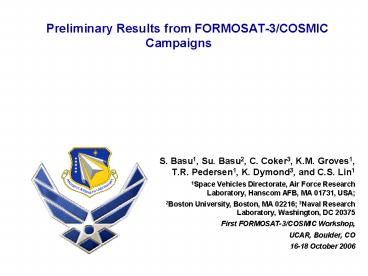Preliminary Results from FORMOSAT3COSMIC Campaigns - PowerPoint PPT Presentation
1 / 31
Title:
Preliminary Results from FORMOSAT3COSMIC Campaigns
Description:
1Space Vehicles Directorate, Air Force Research Laboratory, ... variability of equatorial ionospheric electrodynamics in the dusk sector on a global scale ... – PowerPoint PPT presentation
Number of Views:19
Avg rating:3.0/5.0
Title: Preliminary Results from FORMOSAT3COSMIC Campaigns
1
Preliminary Results from FORMOSAT-3/COSMIC
Campaigns
- S. Basu1, Su. Basu2, C. Coker3, K.M. Groves1,
T.R. Pedersen1, K. Dymond3, and C.S. Lin1 - 1Space Vehicles Directorate, Air Force Research
Laboratory, Hanscom AFB, MA 01731, USA - 2Boston University, Boston, MA 02216 3Naval
Research Laboratory, Washington, DC 20375 - First FORMOSAT-3/COSMIC Workshop,
- UCAR, Boulder, CO
- 16-18 October 2006
2
AFRL Scintillation Network Decision Aid (SCINDA)
3
TIP passes over large area 14 Sep 2006
4
TIP observations over large area on 14 Sep 2006
5
Equatorial Anomaly Formation
- Daytime eastward electric field causes ionized
gas (plasma) to drift upward near magnetic
equator - Plasma subsequently diffuses poleward guided by
magnetic field lines - Process results in enhanced plasma density at
15º magnetic latitude
Anomaly region has greatest effect on RF
propagation
6
TIP passes near allsky imager FOV17 Sep 2006
FM-1 0924 UT
FM-5 1104 UT
FM-3/4 0829 UT
FM-3/4 1004 UT
- Satellites are ascending
- Time of Kwajalein latitude (9.4N) crossing is
provided - Two passes cut across imager field-of-view FM1
and FM5 - Four passes are close enough that moving
structures may be seen by imager at an earlier or
later time
7
TIP 135.6-nm passes near Kwajalein 17 Sep 2006
8
Comparison of TIP and allsky imager17 Sep
2006Strong gradient should be excellent case for
validation, properly calibrated 630.0 nm ASIP
images can be used for such validation
9
(No Transcript)
10
TIP pass directly over SCINDA line-of-sight18
Sep 2006
11
(No Transcript)
12
TEC Fluctuations at Kwajalein on 17Sep 2006
Kwajalein Sept 17,2006 1-min Rate of Change
13
Estimation of S4 index of 244 MHz scintillation
S4 8 ?1.5 (L Sec i)1/2 (dN/NN) (2p/?0) Radio
wavelength, ? 1.23 m Irregularity amplitude
from GPS, dN/N 2 Outer scale ?0 10
km Irregularity layer thickness 100
km, Ionospheric zenith angle, i 200 , From
ionosonde, N 1012 m-3, S4 0.6 at 244 MHz
14
First Impressions!
- TIP and the GPS occultation sensor on
FORMOSAT-3/COSMIC will be useful to study the
variability of equatorial ionospheric
electrodynamics in the dusk sector on a global
scale - TIP will be a viable platform for the study of
the development and collapse of the equatorial
anomaly and its association with the generation
of plasma density irregularities also helped by
TBB - Support by ISRs and ground arrays such as SCINDA
are essential to realize the full potential of
FORMOSAT-3/COSMIC
15
(No Transcript)
16
(No Transcript)
17
(No Transcript)
18
TIP passes near Kwajalein 14 Sep 2006
19
TIP observations near Kwajalein on 14 Sep 2006
structure
20
TIP 135.6-nm data near allsky imager17 Sep
2006(data runs South to North, Kwajalein
latitude crossing indicated, dark count every 37
s, data not calibrated)
21
Comparison of TIP and allsky imager 17 Sep 2006
TIP cuts along depletion, shows structure
FM1 pass 0923-0926 UT
mid lat
22
TIP 135.6-nm passes 17 Sep 20067-13 UT
23
Density and Height17 Sep 2006
24
Depletions and Scintillation
222
25
(No Transcript)
26
(No Transcript)
27
Comparison of TIP and allsky imager 17 Sep 2006
TIP cuts along depletion, shows structure not
seen at 630.0 nm
FM1 pass 0923-0926 UT
28
Comparison of TIP and allsky imager17 Sep
2006Strong gradient should be excellent case for
validation
FM5 pass 1103-1106 UT
9.4N
29
(No Transcript)
30
(No Transcript)
31
(No Transcript)































